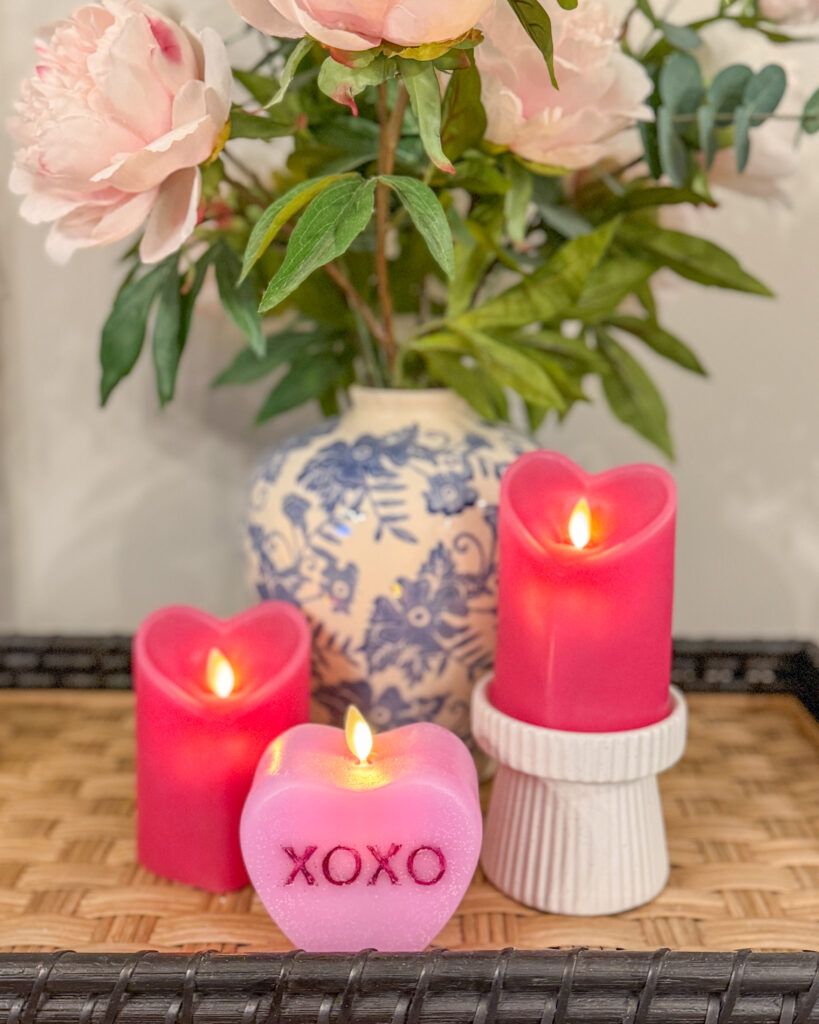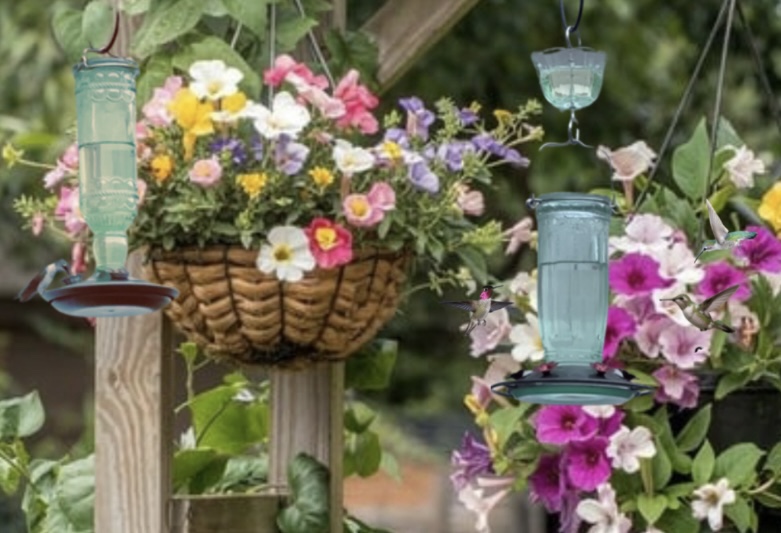
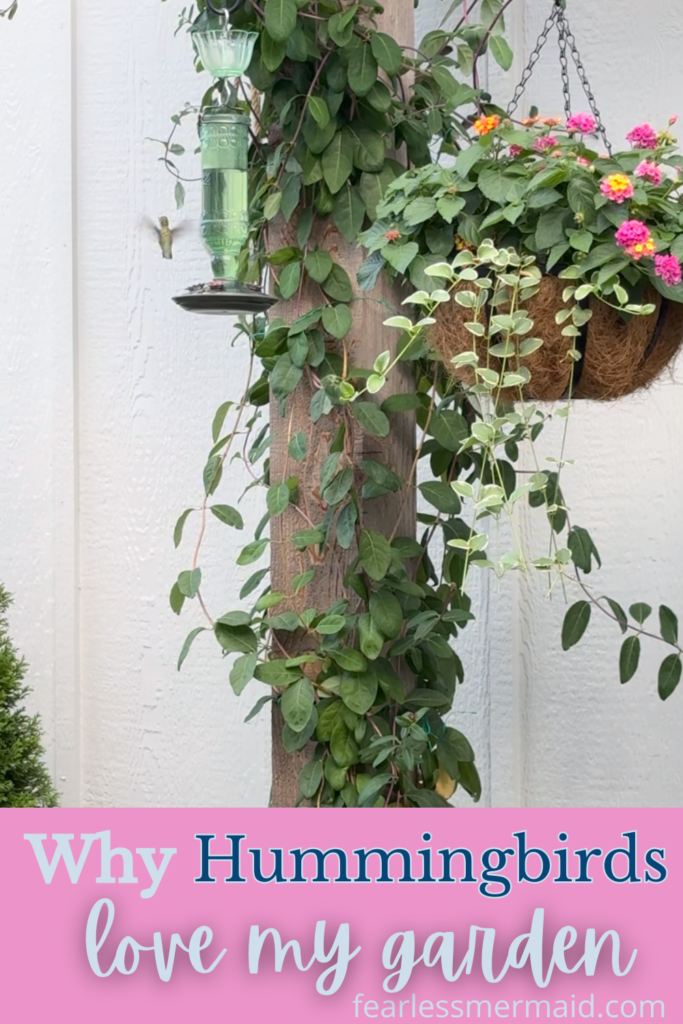
There’s something magical about a hummingbird showing up in your backyard. Tiny wings flutter like a whisper. The bird is here one second and gone the next. At our house, spotting one has become a bit of a family tradition. It all started with a single hummingbird. He zipped in so fast. My daughter and I could barely get the words out before he disappeared. Eventually, we stopped trying to describe him and just named him “Joe.” From then on, every time she’d spot him, she’d shout, “Joe is here!” and I’d catch a glimpse just in time.
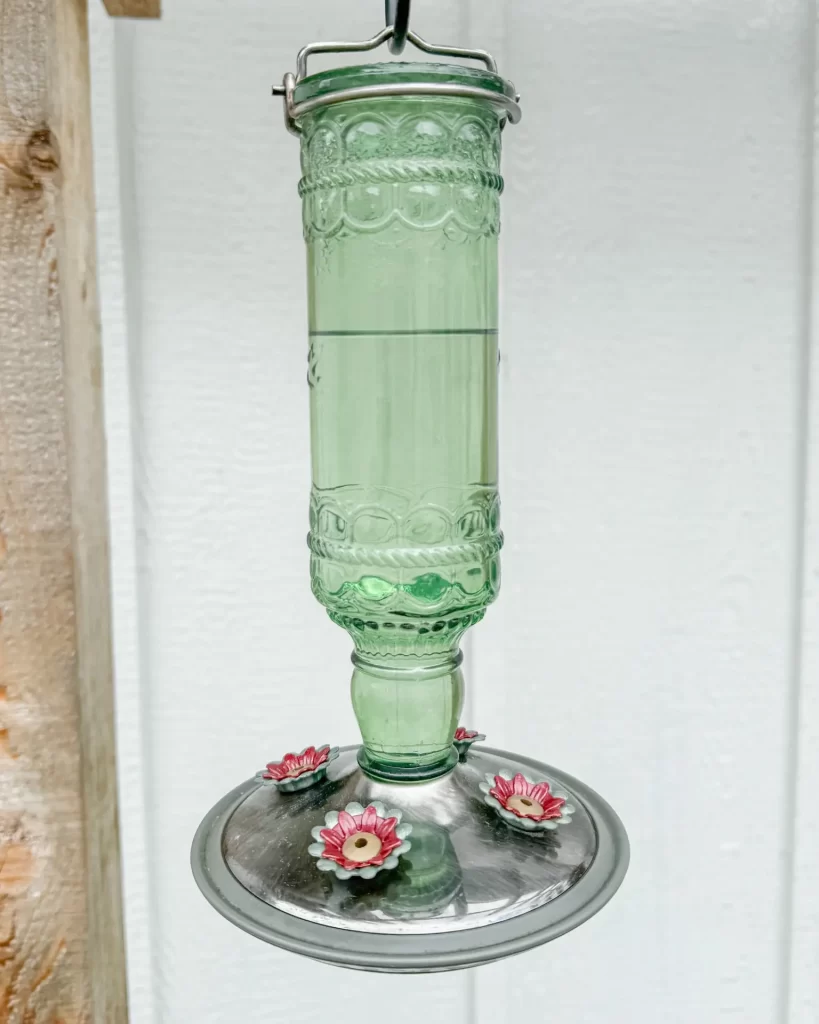
A few weeks later, Joe brought friends. Two more hummingbirds with the same flash of red on their throats (we’re pretty sure that means they’re male?) joined the party, and naturally, we nicknamed them “The Jonas Brothers.”
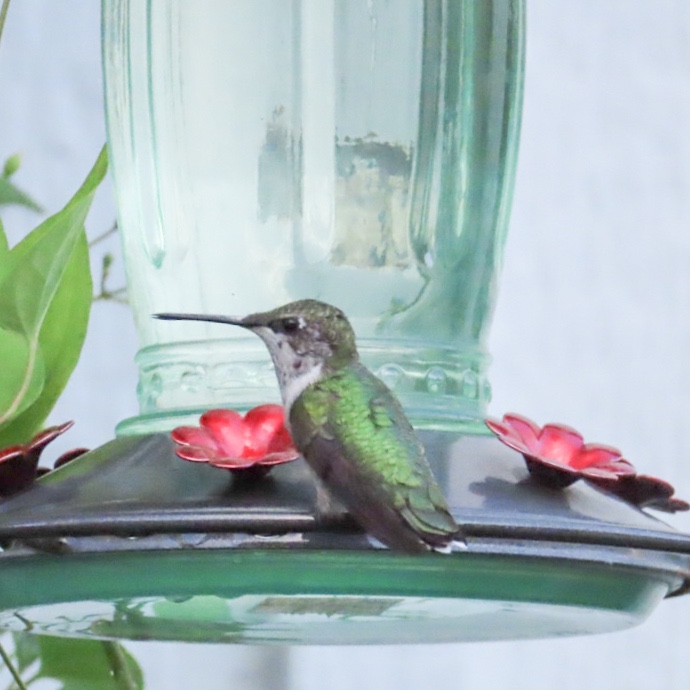
Now, I’ve made it my mission to keep our little bird band happy. I want them coming back, especially under the wooden pergola in our yard where I hang flower baskets and feeders. I’ve been working with a brand I truly love for the last three years. This is the fourth feeder I’ve used from them. Their quality holds up season after season. If you’ve been wanting to attract hummingbirds to your yard or garden, I’ve got a few tried-and-true tips to help you do just that.
Key Takeaways
- Handpicked feeders from Amazon make attracting birds easy and fun.
- Clear-bottom designs and ant moats enhance functionality.
- Budget-friendly options like the Small High Perch feeder are perfect for any yard.
- Easy-to-fill and clean designs save time and effort.
- DIY nectar recipes and maintenance tips will keep your visitors happy.
Introducing Our Top Hummingbird Feeder Picks
Ready to transform your yard into a bird paradise? We’ve curated a list of the best options to attract these tiny, vibrant visitors. Whether you’re looking for premium models or budget-friendly choices, we’ve got you covered!
My Favorite Hummingbird Feeder This Season
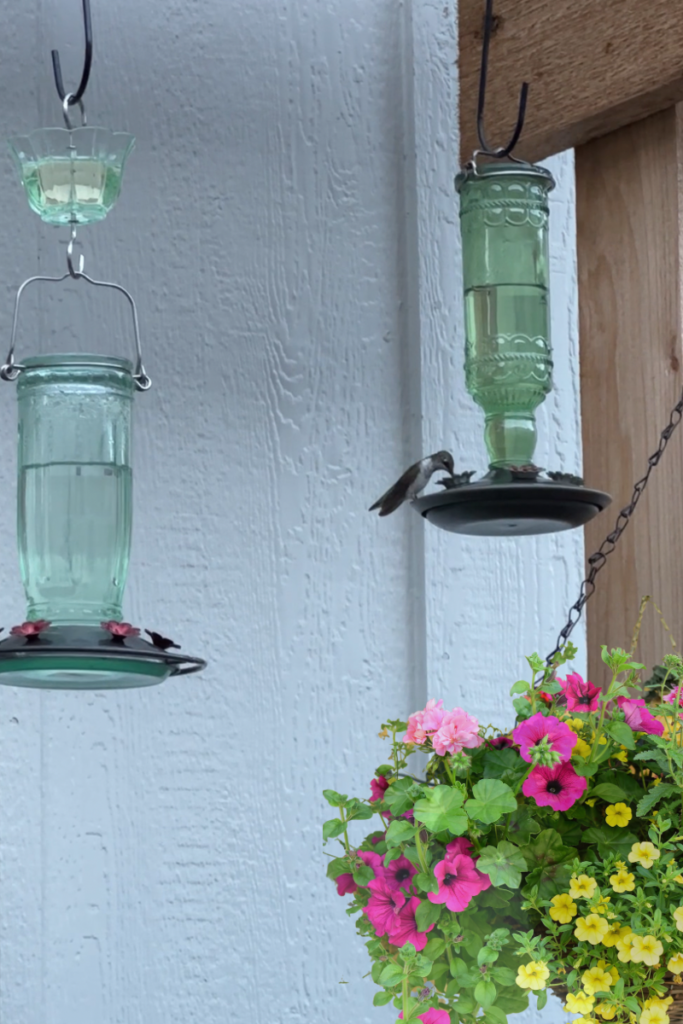
After years of trial and error, I found a brand I trust. A few feeders didn’t survive a full season. That brand is Kingsyard. I’ve used their hummingbird feeders for the past three years. This season marks my fourth one. I’m just as impressed as ever.
What I love most is that they’re easy to clean, sturdy enough to hang under my pergola, and honestly? They’re just pretty to look at. The hummingbirds clearly approve too—Joe and the Jonas Brothers keep coming back.
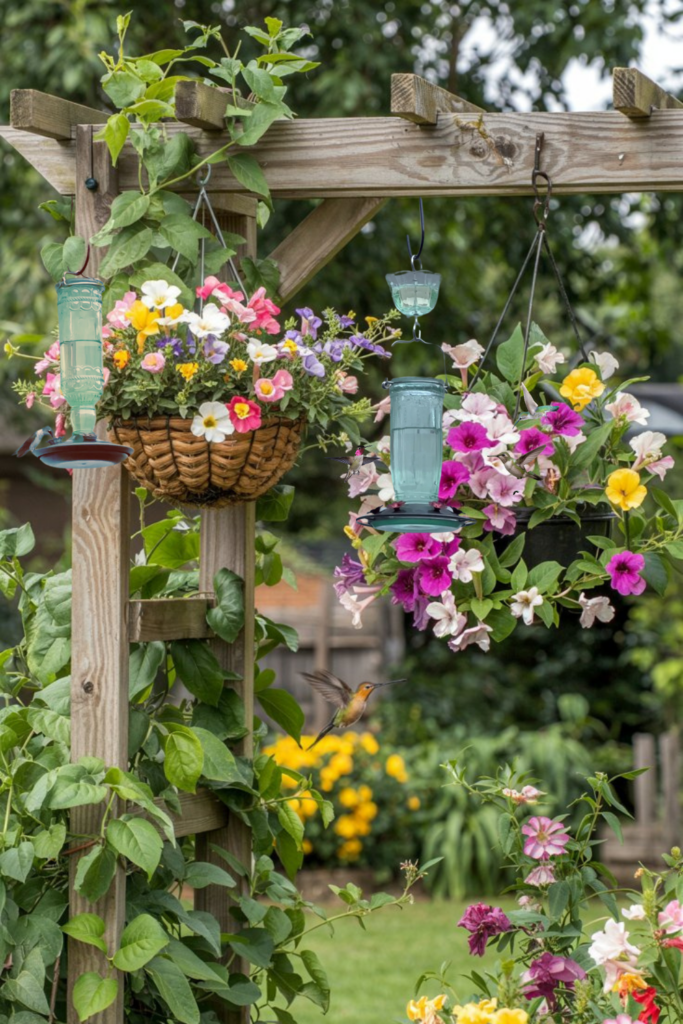
The Kingsyard Glass Feeder, combines style and functionality. The Kingsyard Glass Hummingbird Feeder is an excellent choice for enhancing your garden. It captivates with its vibrant colors. Its generous 24-ounce capacity makes it practical. Featuring six bee-proof feeding ports and an included ant moat, it ensures a comfortable and pest-free environment for hummingbirds. Made from durable glass, this feeder resists fading. It is easy to clean. This provides a healthier option compared to plastic alternatives. Its ease of assembly makes it a hassle-free addition to your outdoor décor. Its leak-proof design attracts hummingbirds with its vibrant colors. The feeder maintains a functional and stylish look. With a high customer rating of 4.7 out of 5 stars, it’s well-regarded for its quality, appearance, and value for money
If you’re just getting started or looking to upgrade your setup, I can’t recommend Kingsyard enough. Their feeders are designed to make nectar refills quick and cleaning simple (no moldy messes here!). Plus, they look beautiful next to my hanging baskets.
[Click the button below to check out the exact Kingsyard feeder I use (Amazon affiliate link)]
These feeders are designed to make feeding simple and enjoyable for both you and your feathered friends.
Unique Designs to Enhance Your Garden
These models not only provide nectar but also serve as beautiful garden accents. With features like ant moats and easy cleaning, they’re practical and stylish. Our picks have been tested and recommended by bird experts, ensuring quality and durability.
Explore these creative designs and make your outdoor space a haven for these delightful visitors!
Features to Look for in a Hummingbird Feeder
Discover the essential features that make a great bird feeder! Choosing the right one ensures your backyard becomes a favorite spot for these vibrant visitors. Let’s dive into the design elements and practical benefits that set high-quality models apart.
Design Benefits of humingbird feeders
A well-designed feeder combines functionality with aesthetics. Look for models with clear-bottom reservoirs. These allow you to monitor nectar levels easily. Wide-mouth bottles make filling and cleaning a breeze, saving you time and effort.
Multiple feeding ports are another must-have. They accommodate more birds, ensuring everyone gets a sip. Comfortable perches let these tiny visitors rest while feeding, giving you a better view of their colorful antics.
Ant Moats, Bee Guards, and Easy Cleaning
Ant moats and bee guards are game-changers. These features keep unwanted insects away, ensuring the nectar stays fresh. Ant moats use water to create a barrier, while bee guards let birds feed without interference.
Cleaning is a crucial part of maintaining a feeder. Models with detachable parts make this task simple. Regular cleaning prevents mold and keeps your feathered friends healthy. Aim to clean your feeder at least once a week, or more often in hot weather.
- Clear-bottom reservoirs for easy monitoring.
- Multiple feeding ports to attract more birds.
- Ant moats and bee guards to keep insects at bay.
- Detachable parts for hassle-free cleaning.
- Stylish designs that enhance your backyard’s look.
With these features, you’ll create a welcoming space for birds while enjoying the beauty of your garden. Happy birdwatching!
Hummingbird Feeder Maintenance Tips
Keeping your backyard visitors happy starts with proper care! Regular maintenance ensures a safe and inviting space for these vibrant birds. Let’s dive into simple routines that make a big difference.
Cleaning Techniques and Frequency
Cleanliness is key to a healthy feeding area. Mold and bacteria can harm birds, so we recommend cleaning your feeder every few days. In hot weather, increase the frequency to prevent spoilage.
Use a bottle brush to scrub all parts thoroughly. Dish soap works well, but rinse carefully to remove any residue. For dishwasher-safe models, a quick cycle can save time and effort.
Disassemble the feeder completely to reach every nook and cranny. Check for cloudiness or mold, and replace the nectar immediately if you spot any. Regular cleaning not only protects birds but also extends the life of your feeder.
Make Your Own Nectar (It’s Easy!)
Fresh nectar is essential for bird health. Mix one part sugar with four parts water for the perfect ratio. Avoid using honey or artificial sweeteners, as they can be harmful.
Bonus tip: Add a note on when to refill (every 2–3 days in heat)
No red dye needed—actually harmful
Bring to a boil, cool, and store in fridge
Change the nectar every 2-3 days, or daily in hot weather. Clear reservoirs make it easy to monitor levels and spot spoilage. Keep the feeder in a shaded area to prolong freshness. The birds may not come back if your nectar has spoiled…we don’t want that! Monitor the temperature, if the nectar gets too hot it can actually burn the little ones throat
By following these steps, you’ll create a safe and welcoming environment for your feathered friends. A little effort ensures they keep coming back to enjoy your garden!
Comparing Materials: Plastic, Glass, and Metal Feeders
Choosing the right material for your bird feeder can make all the difference! Whether you’re looking for durability, style, or ease of cleaning, each option has its own benefits. Let’s dive into the pros and cons of plastic, glass, and metal feeders to help you pick the best one for your yard.
Advantages and Drawbacks of Each Material
Plastic feeders are lightweight, affordable, and less likely to break. They’re perfect for beginners or those on a budget. However, they can warp or fade over time, especially in extreme heat. Regular cleaning is essential to prevent sugar erosion and keep them in good shape.
Glass feeders are stylish and eco-friendly. They don’t warp or fade and can last a lifetime with proper care. Their clear design makes it easy to monitor nectar levels. On the downside, they’re more fragile and can break if dropped. They’re ideal for those who value aesthetics and sustainability.
Metal feeders are durable and often come in sleek designs. They’re great for areas with harsh weather conditions. However, they can rust over time and may heat up quickly in direct sunlight. If you live in a hot climate, this might not be the best choice.
Choosing the Best Option for Your Climate
Your local weather plays a big role in selecting the right material. In hot climates, glass is a great choice because it doesn’t retain heat. For areas with heavy rain or snow, metal feeders are sturdy and weather-resistant. Plastic works well in mild climates but may not hold up in extreme conditions.
Experts recommend considering both functionality and aesthetics.. Match your choice to your climate and personal style for the best results!
By understanding the pros and cons of each material, you can create a welcoming space for birds that’s both practical and beautiful. Happy birdwatching!
DIY Setup and Placement Ideas to Attract Hummingbirds
Transform your backyard into a haven for vibrant visitors with these creative ideas! With the right setup, you can make your garden a favorite spot for these energetic birds. Let’s explore some easy and innovative ways to maximize your space’s appeal.
Watching hummingbirds dance around my garden has become one of my favorite simple pleasures. Whether you plant lantana or just hang a feeder by your kitchen window, you’ll be amazed at how quickly they show up.
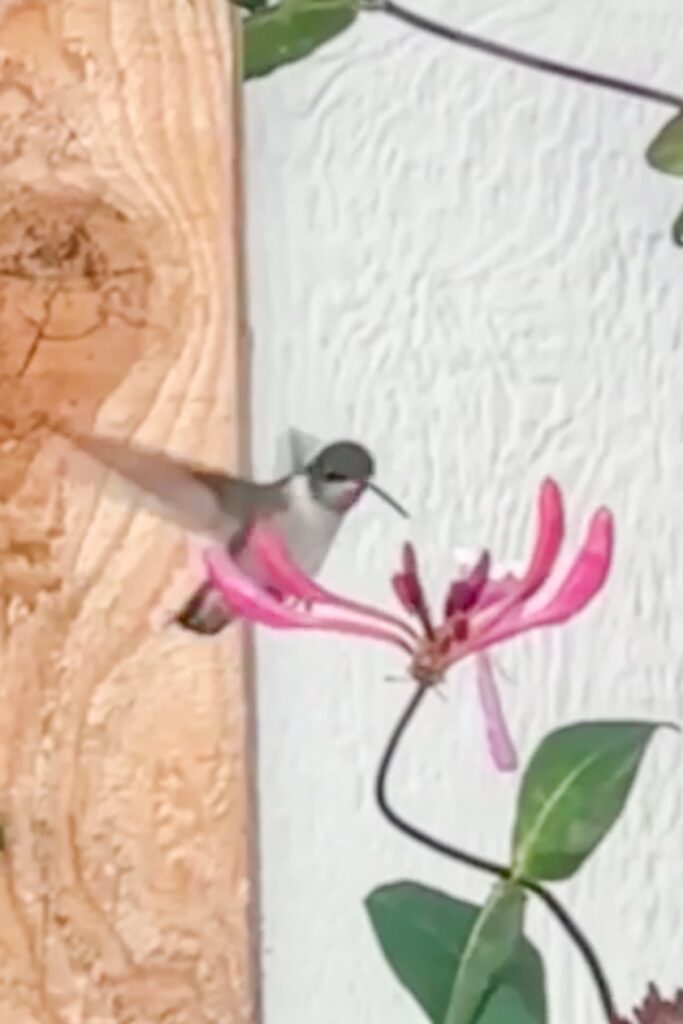
Creative Mounting Options for Your Backyard
Mounting your feeder in the right spot is key to attracting more birds. Try hanging it from a tree branch for a natural look. This gives birds a safe and shaded area to feed. For a closer view, attach it to a window using suction cups. This lets you enjoy their colorful antics up close!
Wall-mounted brackets are another great option. They’re sturdy and can be placed at eye level for easy monitoring. Choose a spot with partial sunlight to keep the nectar fresh longer. Avoid areas with strong winds or heavy foot traffic to prevent spills.
Tips for Optimal Placement
Height and angle matter when setting up your feeder. Aim for a height of 5-6 feet to keep it out of reach of predators. Tilt it slightly to prevent leaks while ensuring birds can access the nectar easily. Experiment with different spots to see where birds feel most comfortable.
Because I have puppies – the hummingbirds eventually adapt to the noise and after a few weeks the pups don’t even look up anymore !
Place your feeder near bright flowers or red accents. Birds are drawn to these colors, making it easier for them to find the feeding area. Keep it at least 10 feet away from dense foliage to give them space to hover and maneuver.
For easy cleaning, choose a spot that’s within reach. This ensures you can refill and clean the feeder without hassle. A well-placed setup not only attracts more birds but also creates a charming view for you to enjoy every day!
Choose the Right Flowers Hummingbirds Love
- Lantana
- Salvia
- Petunia
- Bee balm, columbine, and cardinal flower (optional add-ons)
- red, tubular flowers are their favorite
- Tip: Mix bloom heights and colors for visual interest
- I also plant honeysuckle – which can be invasive so my tip is to plant it in a container to keep the roots contained

Hummingbird Feeder Options Available on Amazon
Amazon offers a wide range of choices to suit every need and style. Whether you’re looking for something stylish or practical, we’ve got you covered!
When to Set Up Feeders for Optimal Attraction
According to Emma Greig from the Cornell Lab of Ornithology, timing your setup with migration patterns is key. In the South, early April is ideal, while late April or early May works best for the North. These periods coincide with their natural journey, making your yard a perfect pit stop.
Blooming schedules also play a role. Birds are drawn to bright flowers, so set up your feeding area near flowering plants. This not only attracts them but also provides a natural food source. Experts recommend using a 4:1 water-to-sugar ratio for homemade nectar, ensuring it’s fresh and safe.
- Set up in early April for the South and late April/early May for the North.
- Align with blooming schedules for natural attraction.
- Use a 4:1 water-to-sugar ratio for fresh nectar.
- Place feeders near flowering plants for added appeal.
Weather changes also matter. In hot climates, change the nectar daily to prevent spoilage. Cooler temperatures allow for 2-3 days between changes. Strategic placement in shaded areas can help maintain freshness longer.
“Aligning your feeder setup with migration and blooming cues ensures a steady flow of visitors. It’s all about working with nature!”
By following these expert tips, you’ll create a vibrant space that birds can’t resist. Thanks to nature’s cues, your backyard will become a year-round haven for these delightful visitors!
Conclusion
Creating a welcoming space for birds is easier than you think! By choosing the right nectar dispenser, you can transform your backyard into a vibrant haven. Look for features like easy cleaning, multiple ports, and durable materials to ensure both functionality and style.
Regular maintenance is key to keeping your visitors happy. Clean your setup every few days with warm water and a mild soap. Place it near bright flowers or a window for the best view. This not only attracts more birds but also creates a peaceful retreat for you to enjoy.
Remember, timing matters! Set up your feeding station in early spring to align with migration patterns.
I hope these tips inspire you to create a beautiful and functional space for your feathered friends. Share your experiences with me and let’s make every backyard a bird paradise!
Introducing Our Top Hummingbird Feeder Picks
The Kingsyard Glass Hummingbird Feeder is a beautifully crafted outdoor accessory designed to attract hummingbirds with its elegant design and vibrant colors. This 24-ounce feeder features six flower-shaped feeding ports, which welcome multiple hummingbirds at a time, making it a lively addition to any garden. The bee-guard ports are specifically designed to deter bees, while the included ant moat helps keep ants away from the nectar, ensuring the feeder remains pest-free.
Constructed with a leak-proof design, this feeder is equipped with a gasket and a secure screw-on base to prevent spills, even in windy conditions. Its wide-mouth bottle facilitates easy filling and cleaning, and it can be completely disassembled for thorough maintenance. This durable glass feeder is not only an excellent choice for personal gardens but also makes a thoughtful gift for bird enthusiasts.
Customers have highly rated this feeder with an average rating of 4.7 out of 5 stars, appreciating its quality and design.
he Kingsyard Glass Hummingbird Feeder is an excellent choice for enhancing your garden with its vibrant colors and generous 24-ounce capacity. Featuring six bee-proof feeding ports and an included ant moat, it ensures a comfortable and pest-free environment for hummingbirds. Made from durable glass, this feeder resists fading and is easy to clean, providing a healthier option compared to plastic alternatives. Its ease of assembly and leak-proof design make it a hassle-free addition to your outdoor décor, attracting hummingbirds with its vibrant colors while maintaining a functional and stylish look. With a high customer rating of 4.7 out of 5 stars, it’s well-regarded for its quality, appearance, and value for money.
thanks for stopping by



